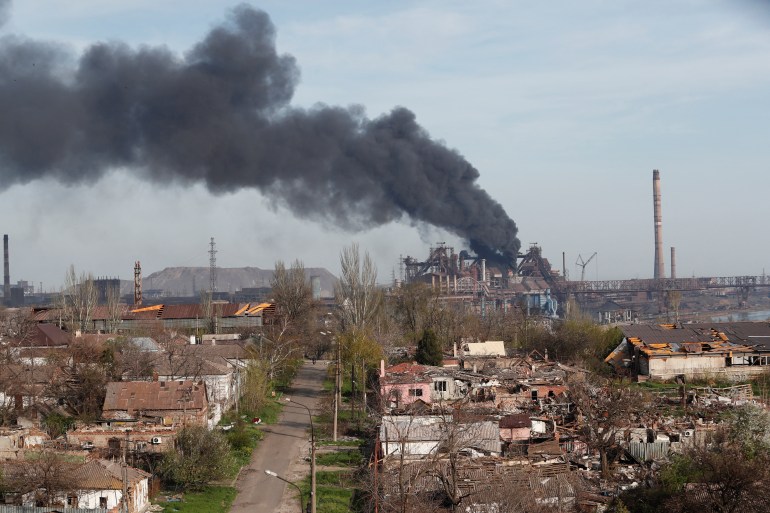All eyes are on Mariupol, southeast of Ukraine, and the focus is on the Azovstal steel plant, which is the last stronghold of Ukrainian forces in the city, after Russian forces have tightened control over most of it.
Local officials in Mariupol assert that the factory shelters hundreds of civilians, and the Kyiv authorities link the fate of all of them to the fate of negotiations with Russia, and offer Moscow the release of "all prisoners" in exchange for their release.
So what is the secret of this factory to get so much attention that it seems that Russia has so far been prevented from storming it or completely destroying it, and for countries and international organizations to intervene to solve the controversy surrounding it?
Smoke rises above the Azovstal plant (Reuters)
precious legacy
1930: The Soviet Union built the "Azovstal" industrial complex on the banks of the Azov Sea, and shelters were built in it according to civil and industrial standards, and it took three years to build.
1933: Work began in the complex, and soon it became one of the pillars of the Soviet Union's industries and economy.
1943: During the Second World War, the complex was completely destroyed after the Nazi forces entered the city of Mariupol.
1947: The Soviet Union rebuilds the huge complex that includes 41 factories and 80 buildings.
1991: The ownership of the factory was transferred to Ukraine after its independence and the collapse of the Soviet Union.
The position of the factory was reinforced by the fact that the city of Mariupol, as well as the Donetsk region and the Donbas region in general, are among the richest lands of Ukraine with coal and iron wealth, in addition to the city's strategic location overlooking the Sea of Azov, across the main port of Mariupol.
The factory owns its own transport networks, including trains and railways, linking it to most parts of the country and its other major ports on the Black Sea.
The factory is the basis for about 40% of heavy industries in Ukraine, according to the Ministry of Economy, and the value of its building is estimated at only $7.6 billion. It also provides jobs for about 12.5 thousand Ukrainians.
The Azovstal steel mills of the Metinvest company owned by Muslim billionaire Rinat Akhmetov still house 2,000 Ukrainian fighters, including members of the "Azov" battalion, whose members Moscow accuses of being "neo-Nazis", with hundreds of civilians in bunkers under the factory.
Inside the bunker in Azovstal in besieged Mariupol (Reuters)
global significance
The factory is the largest of its kind in the European continent, and one of the largest and most prominent mining factories in the world, as it exports its products to about 70 countries, and has branches and offices in 11 countries, including Turkey, Lebanon, Iran and Sudan.
The five furnaces of the factory deal with 3 main raw materials, which annually include about 1.5 million tons of coke, 5.7 million tons of iron ore, and 5.3 million tons of steel.
The factory's many units produce thick, thin, and modified steel plates used in the military, aircraft, ship and automobile industries, as well as railways, electric wires, etc., and pipes used in oil and gas transportation.
Azovstal also produces various types of rolled metals, used in the engine and machinery industries, and the formation of units of various factories and other factories.
highly immunized
- Because of its strategic importance to the Soviet Union and Ukraine after it, the factory was built to be highly fortified against any possible targeting operations, perhaps as is happening today.
According to several Ukrainian circles, in Mariupol and Kiev, the factory’s ceilings and thick walls impeded the Russian forces, and prevented a significant impact on the Ukrainian forces entrenched inside it, despite the bombing of the factory with bombs capable of penetrating fortifications, and this is what prompts them to follow a policy of siege, as President Volodymyr said Zelensky.
The factory is actually built as a fortress, and parts of it are practically underground, and it also includes several cellars and basements, built - apparently - for protection and emergency evacuation, and today it has become a safer haven for thousands of Ukrainian military and civilians in Mariupol, according to its local authorities.

